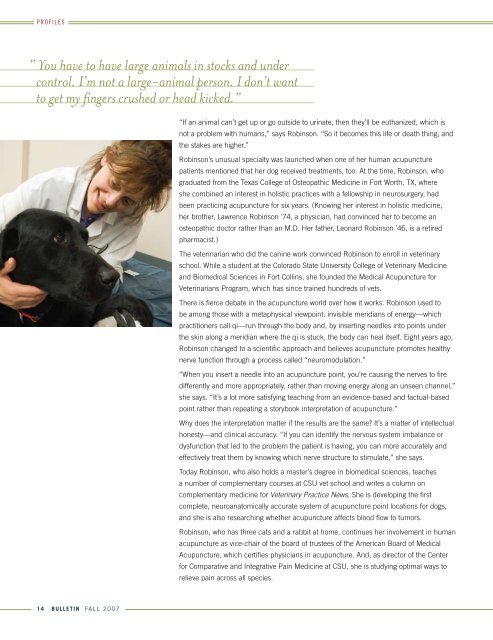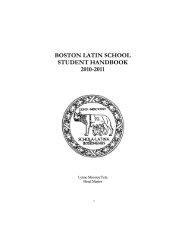A NEW DAY DAWNS - Boston Latin School
A NEW DAY DAWNS - Boston Latin School
A NEW DAY DAWNS - Boston Latin School
You also want an ePaper? Increase the reach of your titles
YUMPU automatically turns print PDFs into web optimized ePapers that Google loves.
ProfiLeS<br />
“ You have to have large animals in stocks and under<br />
control. i’m not a large-animal person. i don’t want<br />
to get my fingers crushed or head kicked.”<br />
14 Bulletin fall 2007<br />
“if an animal can’t get up or go outside to urinate, then they’ll be euthanized, which is<br />
not a problem with humans,” says Robinson. “So it becomes this life or death thing, and<br />
the stakes are higher.”<br />
Robinson’s unusual specialty was launched when one of her human acupuncture<br />
patients mentioned that her dog received treatments, too. At the time, Robinson, who<br />
graduated from the Texas College of osteopathic Medicine in Fort Worth, TX, where<br />
she combined an interest in holistic practices with a fellowship in neurosurgery, had<br />
been practicing acupuncture for six years. (Knowing her interest in holistic medicine,<br />
her brother, Lawrence Robinson ’74, a physician, had convinced her to become an<br />
osteopathic doctor rather than an M.D. her father, Leonard Robinson ’46, is a retired<br />
pharmacist.)<br />
The veterinarian who did the canine work convinced Robinson to enroll in veterinary<br />
school. While a student at the Colorado State University College of Veterinary Medicine<br />
and Biomedical Sciences in Fort Collins, she founded the Medical Acupuncture for<br />
Veterinarians Program, which has since trained hundreds of vets.<br />
There is fierce debate in the acupuncture world over how it works. Robinson used to<br />
be among those with a metaphysical viewpoint: invisible meridians of energy—which<br />
practitioners call qi—run through the body and, by inserting needles into points under<br />
the skin along a meridian where the qi is stuck, the body can heal itself. eight years ago,<br />
Robinson changed to a scientific approach and believes acupuncture promotes healthy<br />
nerve function through a process called “neuromodulation.”<br />
“When you insert a needle into an acupuncture point, you’re causing the nerves to fire<br />
differently and more appropriately, rather than moving energy along an unseen channel,”<br />
she says. “it’s a lot more satisfying teaching from an evidence-based and factual-based<br />
point rather than repeating a storybook interpretation of acupuncture.”<br />
Why does the interpretation matter if the results are the same? it’s a matter of intellectual<br />
honesty—and clinical accuracy. “if you can identify the nervous system imbalance or<br />
dysfunction that led to the problem the patient is having, you can more accurately and<br />
effectively treat them by knowing which nerve structure to stimulate,” she says.<br />
Today Robinson, who also holds a master’s degree in biomedical sciences, teaches<br />
a number of complementary courses at CSU vet school and writes a column on<br />
complementary medicine for Veterinary Practice News. She is developing the first<br />
complete, neuroanatomically accurate system of acupuncture point locations for dogs,<br />
and she is also researching whether acupuncture affects blood flow to tumors.<br />
Robinson, who has three cats and a rabbit at home, continues her involvement in human<br />
acupuncture as vice-chair of the board of trustees of the American Board of Medical<br />
Acupuncture, which certifies physicians in acupuncture. And, as director of the Center<br />
for Comparative and integrative Pain Medicine at CSU, she is studying optimal ways to<br />
relieve pain across all species.



